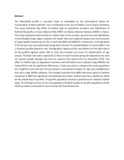| dc.contributor.author | Gathuku, G. N. | |
| dc.contributor.author | Chiawo, D. O. | |
| dc.contributor.author | Warui, Charles M. | |
| dc.contributor.author | Gichuki, C. M. | |
| dc.contributor.author | Ngare, I. O. | |
| dc.date.accessioned | 2021-05-10T09:23:52Z | |
| dc.date.available | 2021-05-10T09:23:52Z | |
| dc.date.issued | 2021-05 | |
| dc.identifier.citation | Preprint from bioRxiv, 01 May 2021 DOI: 10.1101/2021.04.30.442177 PPR: PPR319794 | en_US |
| dc.identifier.uri | https://europepmc.org/article/ppr/ppr319794 | |
| dc.identifier.uri | https://www.biorxiv.org/content/10.1101/2021.04.30.442177v1 | |
| dc.identifier.uri | http://hdl.handle.net/123456789/4637 | |
| dc.identifier.uri | https://doi.org/10.1101/2021.04.30.442177 | |
| dc.description.abstract | The Rothschilds giraffe is currently listed as vulnerable by the International Union for Conservation of Nature (IUCN). This is attributed to the loss of habitat due to human activities. This study examined the effect of habitat type on population structure and distribution of Rothschilds giraffe in Ruma National Park (RNP) and Mwea National Reserve (MNR) in Kenya. The study employed road transects to collect data on the number, age class and sex distribution in three habitat types, open, medium and closed. Data was collected along three road transects of equal lengths measuring 14.2 km in each site (RNP and MNR) for comparison. A driving speed of 20 km per hour was maintained along each transect for standardization of survey effort and a maximum giraffe detection rate. Photographic capture of the coat patterns of the right side of all the giraffes sighted within 500 m from the transect was done for identification of age classes. The field visits were replicated 12 times for each transect giving 36 replications for each site spread equally through wet and dry seasons from March 2017 to November 2018. The effect of habitat type on population structure and distribution was analysed using ANOVA and Tukey HSD to test for significant differences. T-test was used to compare the mean population size of giraffe across the wet and dry seasons. Coat pattern analysis for age class identification was done using WildID software. The findings indicated that MNR had more males to females compared to RNP that registered more females and calves. Habitat type had a significant effect on the distribution of giraffes. The giraffe population showed a preference for medium habitat types. The findings are key for the management of habitat quality for giraffe populations at the interface where conservation areas overlap with human land use. | en_US |
| dc.language.iso | en | en_US |
| dc.title | The effect of habitat type on population distribution and abundance of Rothschilds Giraffe (Giraffa camelopardalis rothschildi) in Ruma National Park and Mwea National Reserve in Kenya | en_US |
| dc.type | Article | en_US |

